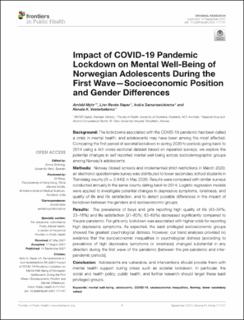| dc.contributor.author | Myhr, Arnhild Ramberg | |
| dc.contributor.author | Naper, Linn Renée | |
| dc.contributor.author | Samarawickrema, Indira | |
| dc.contributor.author | Vesterbekkmo, Renate Kleivhaug | |
| dc.date.accessioned | 2022-08-17T14:47:25Z | |
| dc.date.available | 2022-08-17T14:47:25Z | |
| dc.date.created | 2021-09-27T22:45:45Z | |
| dc.date.issued | 2021 | |
| dc.identifier.citation | Frontiers In Public Health. 2021, 9, 717747. | en_US |
| dc.identifier.issn | 2296-2565 | |
| dc.identifier.uri | https://hdl.handle.net/11250/3012383 | |
| dc.description.abstract | Background:
The lockdowns associated with the COVID-19 pandemic has been called a crisis in mental health, and adolescents may have been among the most affected. Comparing the first period of societal lockdown in spring 2020 to periods going back to 2014 using a rich cross-sectional dataset based on repeated surveys, we explore the potential changes in self-reported mental well-being across sociodemographic groups among Norway's adolescents.
Methods:
Norway closed schools and implemented strict restrictions in March 2020; an electronic questionnaire survey was distributed to lower secondary school students in Trøndelag county (N = 2,443) in May 2020. Results were compared with similar surveys conducted annually in the same county dating back to 2014. Logistic regression models were applied to investigate potential changes in depressive symptoms, loneliness, and quality of life and life satisfaction, and to detect possible differences in the impact of lockdown between the genders and socioeconomic groups.
Results:
The prevalence of boys and girls reporting high quality of life (43–34%; 23–16%) and life satisfaction (91–80%; 82–69%) decreased significantly compared to the pre-pandemic. For girls only, lockdown was associated with higher odds for reporting high depressive symptoms. As expected, the least privileged socioeconomic groups showed the greatest psychological distress. However, our trend analyses provided no evidence that the socioeconomic inequalities in psychological distress (according to prevalence of high depressive symptoms or loneliness) changed substantial in any direction during the first wave of the pandemic [between the pre-pandemic and inter-pandemic periods].
Conclusion:
Adolescents are vulnerable, and interventions should provide them with mental health support during crises such as societal lockdown. In particular, the social and health policy, public health, and further research should target these least privileged groups. | en_US |
| dc.language.iso | eng | en_US |
| dc.publisher | Frontiers | en_US |
| dc.rights | Navngivelse 4.0 Internasjonal | * |
| dc.rights.uri | http://creativecommons.org/licenses/by/4.0/deed.no | * |
| dc.subject | Mental well-being | en_US |
| dc.subject | Adolescents | en_US |
| dc.subject | COVID-19 | en_US |
| dc.subject | Socioeconomic inequalities | en_US |
| dc.subject | Norway | en_US |
| dc.subject | Lower secondary school | en_US |
| dc.title | Impact of COVID-19 pandemic lockdown on mental well-being of Norwegian adolescents during the first wave—Socioeconomic position and gender differences | en_US |
| dc.type | Peer reviewed | en_US |
| dc.type | Journal article | en_US |
| dc.description.version | publishedVersion | en_US |
| dc.rights.holder | © 2021 Myhr, Naper, Samarawickrema and Vesterbekkmo | en_US |
| dc.source.volume | 9 | en_US |
| dc.source.journal | Frontiers In Public Health | en_US |
| dc.identifier.doi | 10.3389/fpubh.2021.717747 | |
| dc.identifier.cristin | 1939384 | |
| dc.source.articlenumber | 717747 | en_US |
| cristin.ispublished | true | |
| cristin.fulltext | original | |
| cristin.qualitycode | 1 | |

